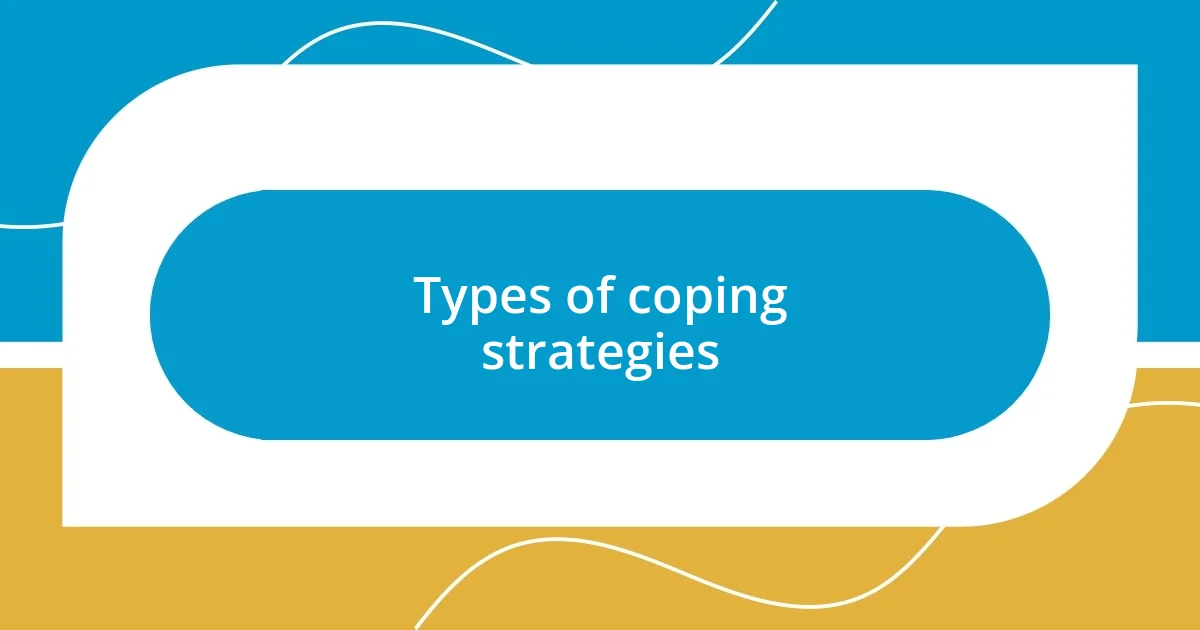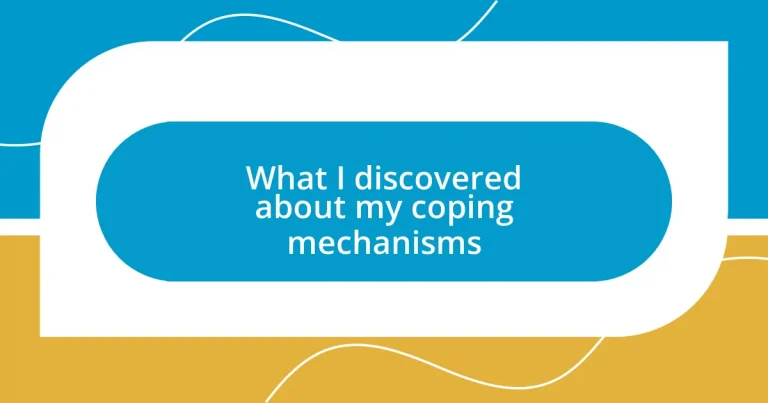Key takeaways:
- Coping mechanisms can be categorized into problem-focused and emotion-focused strategies, each impacting emotional well-being differently.
- Identifying personal triggers and their link to specific coping methods is crucial for understanding and improving one’s emotional responses.
- Building a support system and practicing mindfulness are essential for developing healthier coping techniques and fostering resilience.

Understanding coping mechanisms
Coping mechanisms are the strategies we use, often unconsciously, to manage stress and difficult emotions. I remember when I faced a particularly tough time in my life; I leaned heavily on reading fiction. Losing myself in a different world helped me escape, providing a comforting distraction. I often wonder how many of us have a go-to method that we turn to in times of need without even realizing it.
On another occasion, I found that engaging in physical activity, like jogging, became my way to cope with anxiety. There’s something about the rhythm of my feet hitting the pavement that grants me a sense of control. Doesn’t it make you think about how our bodies instinctively drive us to find relief? This connection between physical activity and emotional well-being is profound and speaks to the complexity of our coping strategies.
Interestingly, I’ve also discovered that some of my coping mechanisms were less healthy than I initially thought. For example, I often turned to late-night binge-watching to numb my emotions. Yet, the following morning, I’d still feel the weight of whatever was bothering me. Isn’t it eye-opening to realize that what may offer immediate relief can sometimes prolong our struggles? Understanding this paradox has been a crucial part of my journey in discovering more effective ways to cope.

Types of coping strategies
When I think about the different types of coping strategies, I can’t help but recall the moments in life where I applied them almost effortlessly. There are two primary categories of coping strategies: problem-focused and emotion-focused. Problem-focused coping involves tackling the source of stress directly, like when I decided to face academic pressure head-on by creating a study schedule. It felt empowering to regain some control over my situation. On the other hand, emotion-focused coping is about managing feelings, like when I would call a friend to vent about my day, allowing me to process my emotions rather than suppress them.
Here are some common types of coping strategies:
– Problem-focused coping: Planning and problem-solving to reduce stress.
– Emotion-focused coping: Seeking emotional support from friends or family.
– Avoidance coping: Distracting oneself through activities like binge-watching.
– Adaptive coping: Engaging in healthy habits like exercise, meditation, or journaling.
– Maladaptive coping: Resorting to unhealthy behaviors, such as substance use or procrastination.
In my experience, recognizing which strategy I was using made a significant difference. For instance, I once used avoidance coping during a stressful work project by diving into video games instead of taking action. While it felt like an escape at the moment, I learned that these strategies often set me back, reminding me that awareness is the first step towards personal growth.

Identifying personal triggers
Identifying personal triggers requires a level of introspection that many of us overlook. In my own journey, I realized that certain situations or emotions would consistently lead me toward specific coping mechanisms. For instance, I found that feelings of overwhelm often nudged me toward late-night snacking as a way to soothe my anxiety. It was almost as if my mind was conditioned to connect stress with comfort food. Isn’t it fascinating how our minds forge such links?
Another critical aspect of identifying triggers is paying attention to physical sensations. One day, I noticed that whenever my heart raced during tense conversations, my impulse was to withdraw and isolate myself. This pattern clearly illustrated how my body reacted before my mind could even fully grasp what was happening. It’s enlightening to explore how our body communicates warnings that we often ignore in the chaos of life.
Once, during a stressful period filled with job uncertainty, I inadvertently identified a major trigger: fear of the unknown. This realization helped me understand why I turned to social media to scroll aimlessly, seeking distraction rather than facing my fears. By tuning into this insight, I was able to replace that habit with journaling, which not only grounded me but also allowed me to express my feelings constructively. It’s all about creating awareness; what triggers your coping methods might be just a heartbeat away from reaching your consciousness.
| Trigger Type | Response |
|---|---|
| Emotional Overwhelm | Late-night snacking |
| Physical Tension | Withdrawing from social interaction |
| Fear of the Unknown | Scrolling social media for distraction |

Evaluating coping effectiveness
Evaluating the effectiveness of coping mechanisms requires a deep dive into how each strategy impacts my emotional well-being. I can recall a time when I leaned heavily on adaptive coping, like going for a run after a tough day. The rush of endorphins left me feeling rejuvenated, proving that not all coping strategies are created equal. This experience helped me realize how important it is to tailor my approach to the specific situation.
In contrast, I often questioned the long-term benefits of maladaptive coping methods, like binge-watching my favorite shows in times of stress. Initially, it felt like a great escape, but later, I found myself feeling more drained and detached from reality. Have you ever noticed this contradiction? It’s almost like I was trading short-term relief for long-term discomfort, which prompted me to reconsider my coping choices.
Ultimately, I’ve started to evaluate my coping strategies by reflecting on their outcomes. For example, practicing mindfulness through meditation has become a go-to for me, providing clarity and peace in chaotic moments. The awareness gained from this practice transformed my approach to stress. When was the last time you reflected on how your coping strategies served you? It’s a powerful exercise, one that continually reshapes my understanding of my emotional landscape.

Developing healthier coping techniques
Developing healthier coping techniques is a journey that requires trial and error. I once found myself overwhelmed during a particularly hectic week, where my go-to response was to dive into a tub of ice cream. It felt comforting momentarily, but soon after, I realized it only added to my feelings of guilt and discomfort. I decided to switch that binge into a ritual of crafting; pouring my energy into art not only distracted me but brought me a sense of fulfillment. Isn’t it amazing how a simple change can profoundly alter our mental landscape?
I also learned the value of connecting with others when things get tough. I vividly recall a day when I felt isolated and trapped in my turmoil. Instead of shutting myself away, I reached out to a close friend. Just talking it out over coffee shifted my perspective entirely. It reminded me that sharing burdens can lighten their weight. Have you ever noticed how a good conversation can transform your day? That connection is often one of the healthiest forms of coping, reinforcing the idea that we’re not alone in our struggles.
In addition, I embraced physical activity as a coping strategy that goes beyond just fitness. One evening, after a long day, I hit the park for a jog. The rhythm of my footsteps and the fresh air somehow eased my racing mind. The experience taught me an essential lesson: movement can release pent-up emotions and create mental space for clarity. Have you ever felt the difference a short walk can make? For me, tapping into such healthy outlets has been a significant step toward developing resilience and a more balanced approach to life’s challenges.

Building a support system
Building a support system has been a transformative experience for me. I remember feeling overwhelmed during a difficult period and reached out to a local support group. The warmth and understanding I found in that room was nothing short of incredible; it reminded me that vulnerability is not a weakness but a bridge to deeper connections. Have you ever felt the power of shared stories? There’s something healing about realizing others have walked similar paths.
One of the most valuable lessons I’ve learned about building a support network is the importance of quality over quantity. Early on, I thought I needed a large circle of friends, but I found that just a few trusted individuals made all the difference. For instance, my cousin has been a steadfast anchor in my life. When I’m grappling with stress, having someone who just “gets it” is invaluable. Have you experienced that one person who seems to know exactly what you need? Those relationships can provide not only comfort but also practical advice that resonates with your unique situation.
Moreover, I’ve discovered the potential in developing new friendships through shared interests. Just last month, I joined a community gardening group. It wasn’t just about the plants; it was about cultivating connections with people who share my passion. Together, we exchanged ideas and tips, while laughter filled the air. This experience reinforced my belief that a support system can flourish in the most unexpected places. When was the last time you stepped outside your comfort zone to connect with others? It’s those moments that often lead to the most enriching relationships.

Reflecting on coping growth
Reflecting on my coping growth has been a fascinating journey. I remember a time when I felt completely lost, rebounding from one strategy to another without truly understanding what worked for me. It wasn’t until I stumbled upon journaling that I discovered a channel for my emotions. Writing each night helped me untangle those chaotic thoughts, and I became aware of patterns in my coping behaviors. Does it ever surprise you how simply putting pen to paper can bring clarity?
As I ventured deeper into self-reflection, I realized that the act of mindfulness became a crucial part of my coping toolkit. There was this one afternoon when I chose to sit quietly in my backyard, soaking in the sounds of nature instead of diving into distractions like my phone or television. The way the breeze caressed my skin and the birds’ songs filled me with a sense of peace I hadn’t experienced in ages. Mindfulness isn’t just a trend; it’s a genuine approach to acknowledging my feelings. Have you ever taken a moment just to breathe and observe? It can be surprisingly grounding.
In my growth, I discovered how essential it was to redefine what it means to cope. It’s easy to equate coping with merely surviving tough moments, but I’ve learned it can also shape how I thrive in my everyday life. Recently, I’ve integrated short creative sessions during my workday—just fifteen minutes to doodle or sketch. Those little breaks not only refresh my mind but also spark joy and creativity in my problem-solving. What’s one small thing you could incorporate into your routine to uplift your mood? It’s these simple shifts that reflect deep growth in my coping mechanisms.














